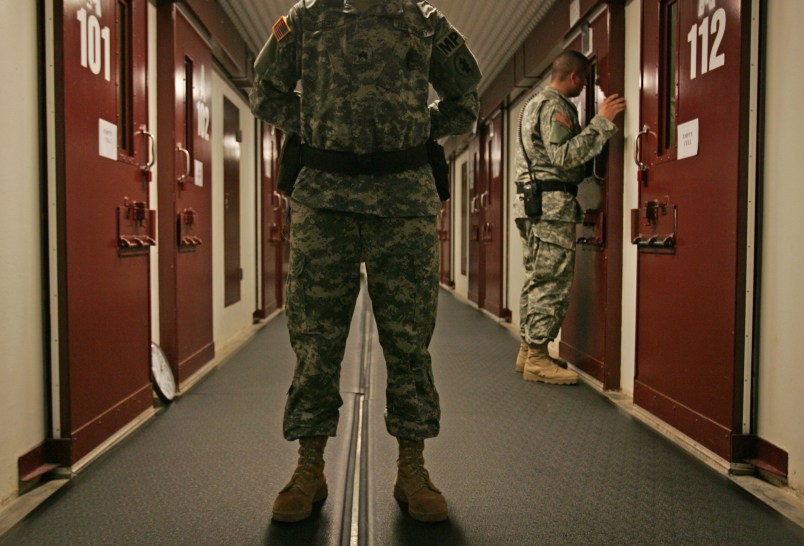WASHINGTON (AP) — A federal judge on Friday ordered the public release of 28 videotapes of a hunger-striking Guantanamo Bay prisoner strike being forcibly removed from his cell and force-fed.
Lawyers for the prisoner, Abu Wa’el Dhiab, have challenged his treatment as abusive.
Numerous news media outlets, including The Associated Press, had asked the court on June 20 to unseal the videotapes, which are classified “secret.”
U.S. District Court Judge Gladys Kessler granted the news media’s request, although Kessler said the tapes will remain sealed until some information on them is redacted. The material to be removed includes identifying information of everyone on the tapes except for the prisoner. She said faces other than Dhiab’s will be obscured, as will voices and names.
“Protection of the identities of Guantanamo Bay staff is a legitimate goal,” Kessler wrote. “Adequate protection can be provided by appropriate audio and visual edits, for example, blurring faces and identifying portions of uniforms, and blacking-out written materials on walls.” The government could appeal her ruling.
Dhiab’s lawyer, Jon Eisenberg, said that “we are very gratified by this decision, which will enable the American people to see with their own eyes the sorts of abuses that are being heaped on these peacefully hunger-striking detainees.”
“Once the truth is fully brought to light, we believe these terrible practices will come to an end,” Eisenberg said.
AP attorney David Schulz welcomed the decision, calling it “a strong reaffirmation of the public’s right to know what their government is up to.”
Dhiab was told in the spring he would be resettled in Uruguay, along with five other Guantanamo prisoners. But as the months have dragged on and the transfer put on hold, his standoff with military officials has only deteriorated, at times turning violent.
On Thursday, the judge rejected a request by the Obama administration to close a hearing into Dhiab’s case scheduled for Monday.
Dhiab, a Syrian prisoner, has been held at the Navy-run prison for terrorist suspects at Guantanamo Bay, Cuba, since August 2002.
The Obama administration has been in court for months seeking to limit the amount of information released in Dhiab’s case.
“The court is well aware, as the government has emphasized, that in no case involving Guantanamo Bay detainees has any court ordered disclosure of classified information over the government’s opposition,” Kessler wrote in a 29-page opinion ordering release of the tapes.
“However — to be clear — that does not mean that in a given factual situation no court has the discretion to do so if warranted,” the judge added.
Standard protocol at penal institutions nationwide is to videotape forcible cell extractions. What’s unusual about these videotapes is that many of them include footage of force-feedings in addition to forcible cell extractions.
AP attorney David Schulz called the decision “a strong reaffirmation of the public’s right to know what their government is up to.”
Hunger strikes at Guantanamo Bay have been taking place since the early days of the island facility’s use as a prison for terrorist suspects following the Sept. 11, 2001 terrorist attacks.
In early 2013, as many as 100 detainees began a hunger strike to protest their uncertain fate. The U.S. has long disclosed how many are refusing to eat and whether they meet military guidelines to be force fed. But late last year, the disclosure ended. A Navy spokesman said in December 2013 that peaceful protest was allowed but that reporting numbers to the public would no longer be done.
The former Navy commander at Guantanamo Bay, Rear Adm. Richard Butler, said in a court declaration filed in July that even though the forced cell extraction videos are lawful, humane and appropriate, they “are particularly susceptible to use as propaganda and to incite a public reaction because of their depiction of forcible … guard interaction with detainees.”
The videos that also contain footage of forced-feedings could be used “to foment anti-American sentiment and inflame Muslim sensitivities as it depicts … personnel providing medical care to a detainee while he is restrained,” Butler said in the declaration.
Making public a video showing a detainee receiving medical care while restrained “would exacerbate the world’s perception of detainees in U.S. custody,” Butler added. “Public release, in whole or in part, of videos showing forced cell extractions” or feedings would cause “serious damage to national security.”
In her ruling, Kessler disputed many of Butler’s points.
After viewing the government videos and analyzing Butler’s arguments, she found that they were “unacceptably vague, speculative, lack specificity or are just plain implausible,” she wrote.
The government has already released substantial information relating to the feeding process, including the layout of and equipment in the feeding space.
“It strains credulity to conclude that release of these videos has a substantial probability of causing the harm the government predicts,” Kessler wrote.
The government argues that releasing the videos would allow adversaries to reconstruct portions of the camp infrastructure, threatening the security of the camps. But the judge noted that much of that information already is in the public domain.
___
Associated Press writer Ben Fox in Miami contributed to this report.
Copyright 2014 The Associated Press. All rights reserved. This material may not be published, broadcast, rewritten or redistributed.







What he means is “serious damage to our standing as a Democracy”.
Another disgusting chapter in the American Story.
This judge obviously fails to appreciate American Exceptionalism.™
He must be impeached. There’s really no other option.
Remember how a judge ordered that the tapes from Abu Gharib must be save yeah. Funny story about that. They were desroyed and the person that destroyed them waltzed away scott free. No problem. So what does everybody guess will happen with these tapes?
Another installment of the abominable Bush legacy of torture that won’t be featured at the George W. Bush Presidential Lie-Bury.
Yes, the feeding tubes should be in the Bush library right next to the 8/6/01 PDB and the copy of The Pet Goat.